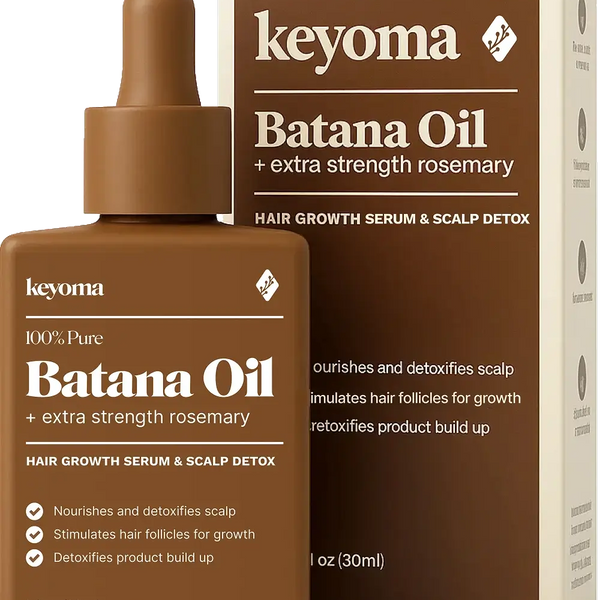In this article
According to a time-series analysis of Google searches spanning more than a decade, global searches for “hair loss” consistently peak around the same seasons each year. That means millions of people worldwide are noticing extra shedding and wondering, what the heck is going on?
Simply put, seasonal hair loss is real. It’s a natural shift that happens as your hair responds to environmental changes at certain times of the year. But the good news is, it’s temporary and manageable.
In this guide, I’ll walk you through why seasonal hair loss happens, what’s normal (and what’s not), and how to support your scalp so you can minimize shedding and keep your strands feeling full and healthy all year round.
Is It Normal To Lose Hair Seasonally?
Yes, it’s completely normal to shed more hair during certain times of the year, particularly from late summer through fall. Much of this comes down to how your hair growth cycle responds to seasonal shifts.
One widely accepted theory suggests that, during spring and summer, increased sunlight exposure prompts the body to delay the exogen (shedding) phase as a protective response against UV rays.
Then, as autumn arrives, many of those hairs enter exogen at once, causing a temporary spike in shedding (we’ll get into the studies on this in a bit).
Another possible factor involves hormonal cues, specifically melatonin and prolactin, which fluctuate with daylight exposure and appear to influence the hair growth cycle.
This idea parallels findings in animal studies, where changes in daylight alter melatonin levels and trigger synchronized follicle shifts in or out of growth. A study on cashmere goats even showed this clearly. Seasonal light changes caused many follicles to shed at once, creating visible shedding peaks.
Of course, humans aren’t goats, and we’re far less photoperiod-driven than they are. But this biological mechanism helps explain why studies and real-world reports consistently show mild, hormonally influenced shedding increases in late summer and early autumn.
In Which Season Does Hair Fall the Most?
For most people, hair falls the most during late summer and early autumn, particularly around August to October. This aligns with most of the studies available yada
A 2009 retrospective study in Dermatology tracked over 800 healthy women complaining of hair loss. Their trichograms revealed the highest percentage of telogen-phase hairs in July, which often translates to increased shedding starting late summer and continuing into fall.
The same study showed the lowest shedding rates in late winter, which confirms that winter isn’t peak hair fall season, contrary to what many assume.
The findings align with an older but still-referenced 1991 study in the British Journal of Dermatology, which followed 14 healthy men for 18 months. It found that hair growth peaked in March, while shedding doubled in August and September.
Researchers linked this pattern to longer daylight exposure in spring and summer—a photoperiod effect—where more follicles simultaneously complete their growth phase and shift into resting (telogen), eventually falling out a few months later.
Interestingly, even pathological hair loss seems to echo this seasonal rhythm.
A 2018 JAAD research letter on alopecia areata found that flare-ups occurred most often in autumn and winter, especially among children. While alopecia areata is different from normal seasonal shedding, the timing overlap suggests that both may share underlying biological cues tied to seasonal change.
How to Stop Seasonal Hair Loss
While you can’t stop the natural hair cycle from turning over, there certainly are ways to treat or reduce seasonal hair loss from getting worse. Here are the best and most effective ways to do that.
Protect Your Hair
Wind, dry air, and UV rays are factors that can stress out your strands in the fall, when humidity drops and heat styling goes up. These exposures strip moisture, weaken the cuticle, and accelerate shedding.
That said, don't forget to wear your hats or use a UV-protectant spray.
When washing, air dry your hair as much as possible to minimize cuticle damage.
And if you’re going outside, wrap your hair in a scarf or switch to protective styles like loose braids or buns.
Don’t Disregard the Conditioner
Skipping conditioner after shampooing leaves your strands vulnerable not only to dryness but also to unnecessary shedding.
When the outer layer (cuticle) stays dry or lifted, it exposes the inner structure of the strand, creating friction that makes hair more prone to tangling, breakage, and weakness, even under mild stress.
This kind of damage becomes especially risky during seasonal hair-loss months when more strands are already in the shedding phase.
A good hydrating conditioner helps seal the cuticle and lock in moisture, keeping your hair smoother, stronger, and less likely to break or shed prematurely.
Look for formulas with glycerin, panthenol, or plant oils, especially if your hair feels extra dry this season. Apply mid-shaft to ends, and let it sit for at least one to two minutes before rinsing.
Trim Hair Regularly
During peak shedding months, your hair is already in a more fragile state. Split ends and frayed strands are more likely to travel upward and snap mid-length, creating the illusion of excess hair fall.
That’s why snipping off those damaged tips every 8 to 12 weeks is vital, as it helps prevent this type of mechanical breakage.
And while you’re at it, consider opting for low-maintenance haircuts instead. During peak seasonal shedding, the less you need to style or manipulate your hair daily, the better, as that means fewer chances for friction, pulling, or breakage.
Detangle Gently
Seasonal dryness makes hair more prone to knots, especially for hair types that are textured or wavy. Ripping through tangles with the wrong tool causes unnecessary breakage that mimics (or adds to) shedding.
Always detangle with a wide-tooth comb or flexible detangler brush. Start from the tips and work upward. And if your hair’s dry, mist with a water–leave-in conditioner mix before combing.
Bonus tip: detangle in the shower with conditioner still in. It provides enough slip to avoid damage.
Eat a Balanced Diet
Nutrient deficiencies can amplify seasonal shedding, leading to more hair fall than your scalp can comfortably handle. That’s because the hair growth cycle is highly sensitive to even small changes in nutrition.
Hair is made of keratin, a protein built from amino acids, and it also relies on nutrients like iron, vitamin D, zinc, and omega-3s to grow and cycle properly.
When your diet lacks these essentials—or when cold-weather cravings for comfort food take over your usual healthy meals—your follicles may respond by entering the shedding phase earlier and staying there longer.
To support your scalp during this vulnerable window, add protein-rich foods like eggs, salmon, or Greek yogurt to your meals. Include iron-rich greens, nuts for zinc, and fatty fish or chia seeds for omega-3s.
(We made a pretty in-depth guide on the Best Foods for Hair Growth if you want to dig deeper into this)
And don’t stop at food alone. Even with a good diet, seasonal shifts and shorter days can quietly lead to deficiencies, especially in vitamin D and B-complex vitamins like biotin.
That said, consider vitamin supplements, but ideally under the guidance of a doctor or nutritionist who can help tailor them to your specific needs.
Apply Nourishing Hair Oils
Nourishing hair oils are rich in essential fatty acids, antioxidants, and anti-inflammatory compounds that target the scalp and follicles directly.
When applied and massaged into the scalp, they help improve microcirculation, bringing more oxygen and nutrients to the hair roots. This becomes especially important during seasonal hair loss, when follicles are more likely to enter the resting phase and slow down activity.
Some of the most trusted oils in the hair care world include:
-
Batana oil
-
Rosemary oil
-
Jojoba oil
-
Coconut oil
-
Peppermint oil
-
Lavender oil
You can even create your own DIY oil blend to layer the benefits.
Apply a light amount of oil daily, or 2–3 times a week if your scalp tends to get oily. Let it sit for at least 30 minutes (or overnight for deeper conditioning), then wash thoroughly to prevent buildup.
Other Common Causes of Hair Loss
Here's the thing: just because you’re shedding more hair during late summer or fall doesn’t automatically mean you’re dealing with seasonal hair loss.
For all you know, it could be something more chronic—or even medical. That’s why it’s important to recognize when shedding falls within the range of normal versus when it could signal something else entirely.
Here are a few of the most common culprits:
-
Androgenetic Alopecia (Pattern Hair Loss): A genetic condition where hair thins gradually, most often at the crown or temples. Unlike seasonal hair loss, this doesn’t grow back on its own.
-
Telogen Effluvium: Often triggered by stress, illness, or major life changes (like surgery or childbirth). It causes sudden, diffuse shedding—similar to seasonal hair loss—but tends to persist longer and needs proper identification.
-
Alopecia Areata: An autoimmune disorder that causes patchy bald spots. Links have been made to shedding being seasonal, but generally, it’s often abrupt and uneven.
-
Thyroid Disorders: Both hypothyroidism and hyperthyroidism can disrupt your hormone balance. More strands shift prematurely into the shedding phase, resulting in thinning, especially around the edges and crown.
-
Nutritional Deficiencies: Inadequate levels of iron, zinc, vitamin D, or protein deprive hair follicles of the raw materials they need to grow or maintain length. Iron deficiency, in particular, has been closely linked to increased hair fall in multiple studies.
-
Fungal Infections or Scalp Conditions: Conditions like dandruff, seborrheic dermatitis, or ringworm don’t just cause flaking or itchiness. They also inflame the scalp and damage the follicle environment, which can contribute to hair loss if not treated properly.
If your shedding comes with symptoms like itching, pain, visible patches, or continues beyond a few months, we recommend seeing a dermatologist.
How Long Does Seasonal Hair Loss Last?
Seasonal hair loss typically lasts around 6 to 12 weeks (about 2 to 3 months). However, the exact timeline varies from person to person and depends largely on how well you support your scalp and follicles during this phase.
You can help your hair recover faster by applying nourishing oils, maintaining a diet rich in iron, protein, and healthy fats, and trimming your ends regularly to prevent breakage from adding to the natural shedding.
On the other hand, if your routine lacks moisture and nutrients—or if you frequently deal with breakage from tight hairstyles, poor diet, or overstyling—it might take longer for your growth phase to bounce back.
What Triggers Seasonal Hair Loss?
Seasonal hair loss is triggered by a few overlapping factors:
-
Photoperiod changes: As daylight hours shorten in late summer and fall, melatonin and prolactin levels shift. These hormonal changes subtly influence the timing of your hair growth cycle.
-
Environmental stressors: Dry air, UV exposure, and temperature changes can dehydrate the scalp and weaken follicles.
-
Delayed response to summer growth: Hair that was kept in the growth phase during spring and early summer begins transitioning into telogen (resting phase) as autumn nears, leading to more shedding.
Frequently Asked Questions (FAQs)
Does seasonal hair loss grow back?
Yes, in most cases, seasonal hair loss does grow back. This type of shedding is temporary and part of the natural hair cycle. As long as your scalp is healthy and your follicles are still active, the hair that falls out during the shedding season will typically regrow within a few months.
Can seasonal allergies cause hair loss?
Yes, but indirectly. Seasonal allergies can trigger scalp inflammation due to constant itching or histamine response. Inflammation disrupts the environment around your follicles and may push some strands into the shedding phase earlier than usual. While it’s not the most common seasonal hair loss cause, it can still play a supporting role.
What month is hair fall season?
Hair fall season usually peaks between August and October, though this may vary slightly depending on your climate and location. Many people notice the most shedding during the early part of autumn.
Does hair shed more in summer?
If you’re asking about late summer, then yes—this is actually when seasonal hair shedding starts to become more noticeable. By this point, many hairs that quietly entered the telogen (resting) phase back in mid-summer are now beginning to shed.
Support Your Hair Through the Seasons
Seasonal hair loss can feel alarming when it shows up in your brush or clogs your shower drain, but more often than not, it's temporary, and with the right habits, you can get through it without long-term damage.
Personally, one thing that’s helped me during seasonal shedding is applying nourishing hair oils, especially a blend of batana and rosemary oil. It's made detangling much easier and it’s pretty lightweight too—perfect for anyone just getting started with scalp oils or worried about buildup.
Want more guides like this? Head over to the Keyoma Hair Care Blog for more guides, routines, and hair health ideas that actually work.
Featured Product
100% Pure Batana Oil + Rosemary









